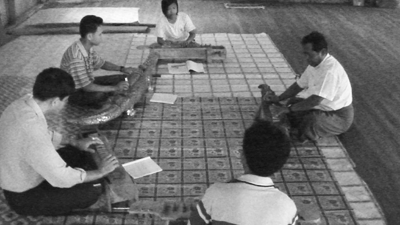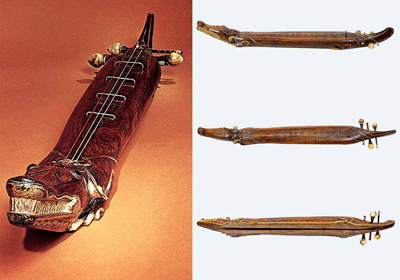Crocodile Fears

Mon musicians throw the spotlight on a threatened traditional instrument.
It’s called a “crocodile” because of its shape, but all associations linking the feared predator and this ancient Mon musical instrument end there. Despite its name, the Mon crocodile is a thing of beauty, producing beautiful sounds. And, like so many remnants of the past, it’s under threat.
 |
| Mon students carefully observe a “crocodile” teacher. |
Ironically, the successful Burmese rock band Iron Cross is helping to save the traditional instrument by incorporating it in the group’s repertoire. A song with the significant title “The Sound of a Sobbing Crocodile” is featured on an Iron Cross album, performed by the group’s lead guitarist Chit San Maung and the famous Mon singer Lawi.
Lawi wrote the song, referring to the instrument’s early Chinese associations with lines such as “Let me drink water from the Yangtze River” and “Let me fly back to my old place.”
Lawi says he wrote the song “with the intention of describing the current situation of an almost extinct Mon traditional instrument.”
A typical “crocodile” is just over a meter in length. It has a carved crocodile head, four limbs and is usually covered in crocodile hide or colorful floral arabesques.
The instrument has three strings, which the Mon say represents the concepts of Buddha, Dhamma and the Sangha community of monks.
 |
| A young performer plays a traditional melody on his “crocodile.” |
The origins of the Mon “crocodile” date back at least 1,200 years, according to both historical records and Mon mythology. It first entered the history books when a diplomatic mission sent by a 9th-century Pyu king presented a Chinese emperor of the Tang dynasty with a collection of more than 20 musical instruments that included two Mon crocodile-headed harps. The Chinese called the instrument Kun Lun, which means Mon.
The mythical account of how the Mon acquired the “crocodile” is much more fanciful. It relates how King Okkalapa of Dagon ordered the instrument to be made in memory of his son, Prince Nandar, who is said to have died while trying to cross a river on the back of a crocodile on his way to reach the girl he loved.
The “crocodile” fell out of favor after the collapse of the Mon kingdom more than 250 years ago. Despite current efforts at reviving interest in the instrument, only half a dozen musicians play it professionally, according to Mon musicologist Htaw Paing.
“Since the fall of the Mon kingdom, Mon people haven’t been able to freely preserve and hand their own music down to later generations, so those who can play the ‘crocodile’ have become very rare,” said Han Win Aung, who makes “crocodiles” in his Paung Township workshop.
 |
| Exquisite 19th-century “crocodiles” |
Han Win Aung receives about three orders a year. Each “crocodile” takes two months to make and costs about 300,000 kyat (US $300)—too much for the pockets of young musicians such as Nay Lin Htun, who believes the high cost of the instrument is one factor dampening popular interest.
Another problem faced by “crocodile” enthusiasts is the arcane nature of its repertoire.
1 | 2 next page »
